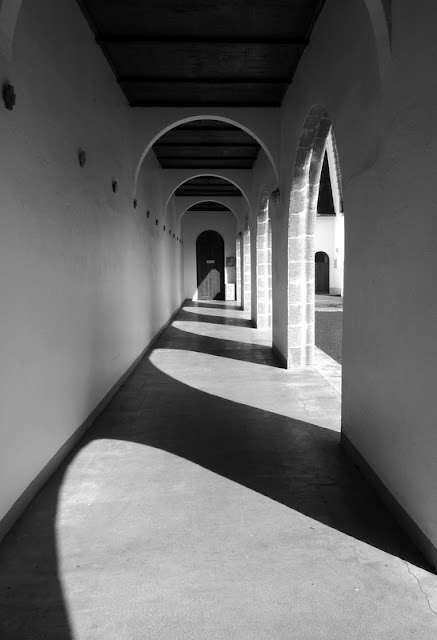A perfect All Hallows Eve, we drove up to the coast and walked, watched a surprisingly surfy sea for the Bay, little spray-topped curling waves and a collection of kite surfers enjoying them, their kites bowed over like herons' wings.
On the way, raggedly effusive reds and pinks of lingering geraniums, petunias and roses embroidered the backdrop of gold-brown-yellow-orange leaves. Where have the field maples been until now, how is it they only become visible in autumn? The shimmery, sandalled verticals of the poplars are best of all though. I know Tolkien divides people fiercely, but I hold to the middle ground, or sit on the fence if you like; I remember someone saying about Wagner that, all his sins notwithstanding, he sometimes entertained angels unawares, and that's rather how I feel about Tolkien*. I can't look up into autumn-turning poplar woods without the word Lothlorien speaking itself to me.
We'd cried off a dinner date for this evening and have relished the relief of doing so all day. I lit the first fire of the season - having cleared out the grate including a poor dead sparrow and the soot it had brought down with it - and soon was pulling off fleece and thick socks and experiencing delightful levels of warmth - we've turned our radiators on but are resolutely leaving the thermostat at 18˚, and so far they've barely come on, but it's started feeling slightly damp and chilly at times. I made a stewy-soup with chicken and butter-nut pumpkin and chestnuts and dumplings in it, among other things, and we were warmer still. And just before that there was some unaccustomed noise and commotion in the road, and peering out we saw some eerie small personages outside.
Now trick-or-treat may be commonplace for better or worse to most of you in the Anglo world, but here it's still not widespread. Some years I make pumpkin lanterns, and soup or pie from their insides, and our elderly neighbours used to look with bafflement on them in the window and remark that it was a bit early for Christmas, and they were equally nonplussed about the pie. Since the family next door (not Charmless, the other side) nearly broke our hearts a couple of years ago by moving away to live down the road in a big smart new house the bourg without saying goodbye, I haven't bothered putting the Jack O'Lanterns in the window, though I might put one on the hearth. They didn't slip off without saying goodbye ( filer à l'anglaise, as the expression goes) because they didn't like us, I'm sure, but out of a kind of shyness, a dislike of departure, not wanting to fuss, or upset the children, or something. But we were fond of them; Sarah used to come to the downstairs window sill when she was barely high enough to look over it and repeat 'Il est où, Tom?' so that sometimes Tom used to duck out of sight to be able to get on with whatever he was doing. We've seen them around since of course, and before they let it to the elderly lady who's there now, I asked Gwen, the mother, what they might do about the little old house which was still empty. She said that they weren't allowed to think of selling it as Sebastian, who's eleven, insists that as soon as he's old enough he's going to come back and live there, as he was so happy here.
But there on our doorstep were three wee horrors, Sebastian, Sarah and their cousin Laure, with a paper bag, big grins, wigs, hats and face paint. We made a show of astonishment and non-recognition and Sebastian, being in charge, hastily informed us that he was Sebastian, and this was Sarah. No, I said, that is a small witch. No, really, he said, it was Sarah, who opened her mouth to reveal vampire fangs, at which we squealed dutifully. I wished I'd made the butter-nut into a lantern.
Thankful for our boiled sweet habit, I dug into the jar and dropped a handful into the paper bag. They trooped off and Gwen, who was taxi-driving in the background, gave us a cheery wave and said that they knew they could come to us as we'd know all about it. We waved them off and told them what a pleasure it was to see them and how beautiful they were, and really meant it. We kept grinning about it for the rest of the evening.
* and all his angels notwithstanding, his poetry was truly awful.
~
Well, the first fire, Halloween, golden groves unleaving, and its the time of year for daily blogging again. I know a lot of people are sniffy about Nablopomo as a slavish following of what others begin, an affront to their freedom of spirit, last year's model, a grotesque acronym etc, but no one has to do it, and I enjoy the push to daily practice and the opportunity to use up odds and ends, so I'm giving it a go as usual. See you tomorrow.
~
(Window carving, Saffron Walden church. Apropos of nothing much.)








































